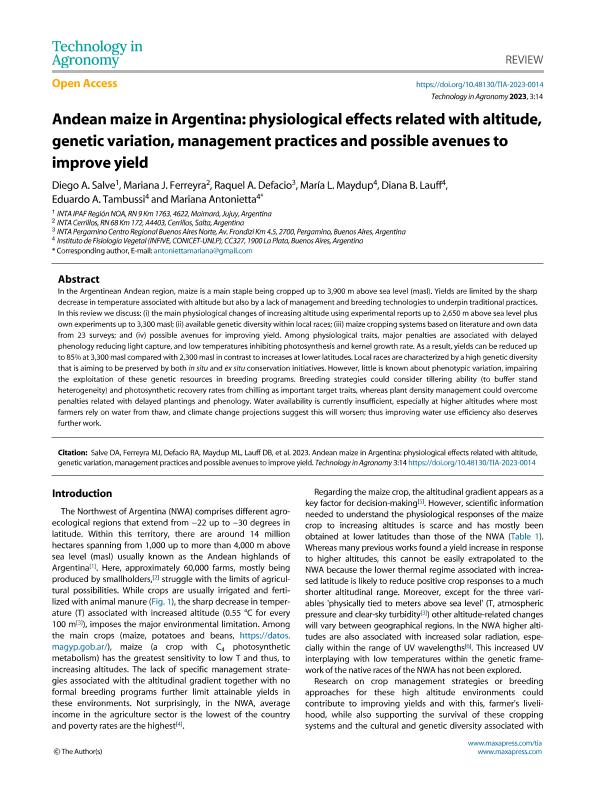Artículo
Andean maize in Argentina: physiological effects related with altitude, genetic variation, management practices and possible avenues to improve yield
Salve, Diego Antonio ; Ferreyra, Mariana J.; Defacio, Raquel Alicia; Maydup, Maria Luján
; Ferreyra, Mariana J.; Defacio, Raquel Alicia; Maydup, Maria Luján ; Lauff, Diana Beatriz
; Lauff, Diana Beatriz ; Tambussi, Eduardo Alberto
; Tambussi, Eduardo Alberto ; Antonietta, Mariana
; Antonietta, Mariana
 ; Ferreyra, Mariana J.; Defacio, Raquel Alicia; Maydup, Maria Luján
; Ferreyra, Mariana J.; Defacio, Raquel Alicia; Maydup, Maria Luján ; Lauff, Diana Beatriz
; Lauff, Diana Beatriz ; Tambussi, Eduardo Alberto
; Tambussi, Eduardo Alberto ; Antonietta, Mariana
; Antonietta, Mariana
Fecha de publicación:
11/2023
Editorial:
Maximum Academic Press
Revista:
Technology in Agronomy
ISSN:
2835-9445
Idioma:
Inglés
Tipo de recurso:
Artículo publicado
Clasificación temática:
Resumen
In the Argentinean Andean region, maize is a main staple being cropped up to27 3900 meters above the sea level. Yields are limited by the sharp decrease in temperature28 associated with altitude but also by a lack of management and breeding technologies to29 underpin traditional practices. In this review we discuss (i) the main physiological changes30 of increasing altitude using experimental reports up to 2650 meters above the sea level31 (masl) plus own experiments up to 3300 masl; (ii) available genetic diversity within local32 races; (iii) maize cropping systems based on literature and own data from 23 surveys; and33 (iv) possible avenues for improving yield. Among physiological traits, major penalties are34 associated with delayed phenology reducing light capture, and low temperatures inhibiting35 photosynthesis and kernel growth rate. As a result, yields can be reduced up to 85% at36 3300 masl compared with 2300 masl in contrast to increases at lower latitudes. Local races37 are characterized by a high genetic diversity that is aiming to be preserved by both in situ38 and ex situ conservation initiatives. However, little is known about phenotypic variation,39 impairing the exploitation of these genetic resources in breeding programs. Breeding40 strategies could consider tillering ability (to buffer stand heterogeneity) and41 photosynthetic recovery rates from chilling as important target traits, whereas plant42 density management could overcome penalties related with delayed plantings and43 phenology. Water availability is currently insufficient, especially at higher altitudes where44 most farmers rely on water from thaw, and climate change projections suggest this will45 worsen; thus improving water use efficiency also deserves further work.
Palabras clave:
MAIZE
,
HIGHLANDS
,
ANDEAN
,
PHYSIOLOGY
,
MANAGEMENT
,
GENOTYPIC VARIATION
Archivos asociados
Licencia
Identificadores
Colecciones
Articulos(INFIVE)
Articulos de INST.DE FISIOLOGIA VEGETAL
Articulos de INST.DE FISIOLOGIA VEGETAL
Citación
Salve, Diego Antonio; Ferreyra, Mariana J.; Defacio, Raquel Alicia; Maydup, Maria Luján; Lauff, Diana Beatriz; et al.; Andean maize in Argentina: physiological effects related with altitude, genetic variation, management practices and possible avenues to improve yield; Maximum Academic Press; Technology in Agronomy; 3; 1; 11-2023; 1-24
Compartir
Altmétricas



